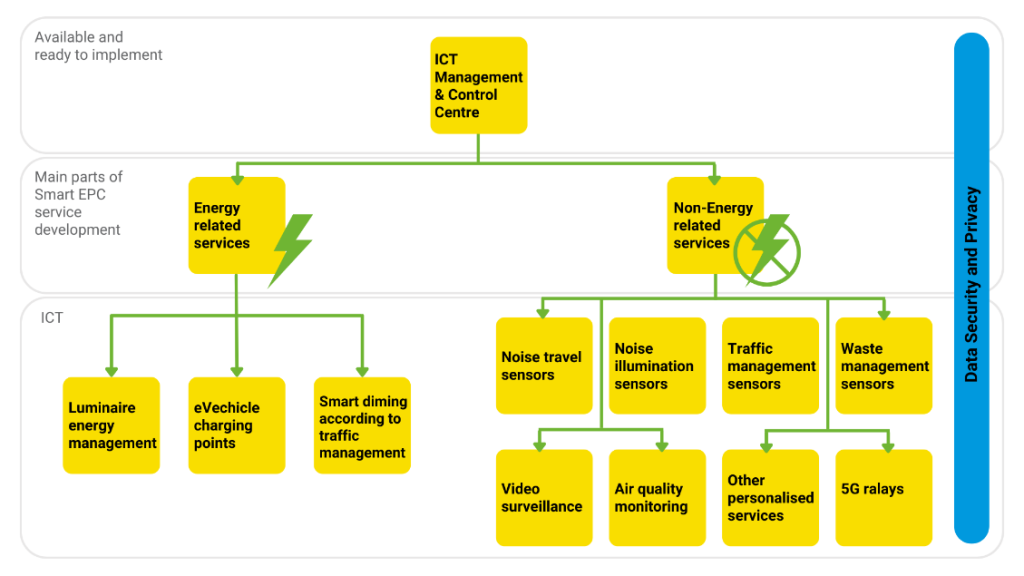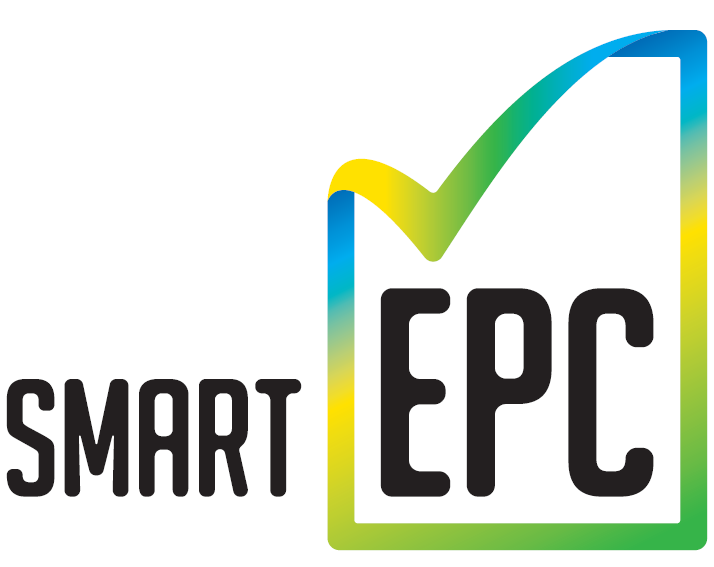Refurbishment of old and inefficient public lighting units with integration of Internet of Things (IoT) technology and Smart City components will pave the way for a wide range of energy and non-energy services and applications. Those include public safety, traffic management, electric vehicles (EV) charging, environmental monitoring, and next generation of cellular communications (e.g. 5G).
The main objective of the EU-funded Smart EPC project is to enable the transition towards smart sustainable cities and municipalities by making energy efficiency a key for unlocking potentials of new, emerging technologies and services.
Towards smart, energy-efficient cities
The Smart EPC project will achieve this aim through a set of key activities:
- integration of energy services (e.g. EV charging) and non-energy services (e.g. 5G and Smart City infrastructure) in the public lighting infrastructure
- development of standardised EPC contract that includes a pay-for-performance scheme (real time data on performance of public lighting infrastructure)
- testing of the Smart EPC concept (piloting reconstruction of existing lighting by using standardised EPC contact, that integrates other energy and non-energy related services).

The Smart EPC outputs are structured around three specific objectives. The first objective is the development of standardised Smart EPC documentation for integration of energy and non-energy services in energy performance contracting (EPC). The project will test the reconstruction of public lighting by including other energy and non-energy services (e.g. Smart City components like e-mobility charging stations, 5G relays for data transfer and communication, etc.) thus making EPC more attractive and financially viable to local authorities.
The second project objective is the demonstration of the replication potential of Smart EPC documentation by piloting the reconstruction of public lighting systems. The goal is to demonstrate the viability and effectiveness of project outputs (e.g. developed standardized processes and documentation). These demo actions will be done in three pilot countries across Europe (Spain, France and Poland) with different market and regulatory circumstances.
Third project objective is capacity building, replication, and strong facilitation/dissemination service. Throughout the project, the partner organisations will design and deliver a capacity-building programme addressed to local authorities and consultants not part of the project, aiming to improve their knowledge and skills in EPC.
What financing models for Energy Performance Contracting (EPC)?
There is a range of financing models in place, from traditional city ownership and operation to concessions for lighting and smart services. Cities can consider several business models, financing and funding options to ensure that they chart a course that is as suitable as possible for them.
Energy performance contracting presents a contractual model where the provider of service, also known as energy service company (ESCO), delivers energy efficiency service to its client.
The energy efficiency service can include delivery of work, replacement of equipment, management of energy systems and other actions that collectively are usually called energy efficiency measures. These measures must result in energy savings without influencing the “normal” use of the facilities or infrastructure by the client. Energy performance contracts are essentially performance-based contracts, since the payment to the energy service company is linked to the level of energy savings they have provided to the client during the contractual period – and not to the direct cost of energy measures they have implemented. All implemented measures are financed by ESCO and are repaid through regular payments to ESCO by the client, for energy savings provided during contractual period. This type of contractual model efficiently links desired outcomes to provided payments ensuring that the clients “pay only what they really get” and allocates performance risks on ESCOs. For an efficient transfer of performance risks to the energy service company, a robust monitoring system needs to be implemented. Measurement and verification of achieved energy savings is crucial to every energy performance contract since payments rely on achieved energy savings.
How about the practice and market maturity of Energy Performance Contracting in the EU?
Even though the beginnings of Energy Performance Contracting dates to around 30 years ago in the United States, its implementation in the EU started to evolve profoundly only in the past 15 years, when energy services and energy performance contracting started being promoted trough the Energy Services Directive (2006/32/EC). Energy performance contracting evolved in many different forms of contracting models in the EU countries. Most differences between these contracting models lies mainly in the ways the ESCO companies guarantee savings (performance guarantees, payment mechanisms, guarantees on energy savings, etc.). However, the essential part of the energy performance contracting or allocation of performance risk to the ESCO company is present in all cases.
In 2021, the Joint Research Centre (JRC) of the European Commission released the report “Energy Performance Contracting in the Public Sector of the EU – 2020”, in which a comprehensive overview of EPC in the EU market is presented. Findings reveal a very diverse picture when it comes to the maturity of national EPC markets across EU countries, as well as predictions for future growth. The report also identifies several barriers, as well as policy recommendations to foster the growth of the EPC market across EU. Perception of complexity, administrative, and transaction costs of EPC projects is seen as a barrier in stronger growth of EPC market and standardisation of preparatory procedures and analysis, as well as standardisation of contract documentation that is one of Smart EPC’s objectives can help overcoming this barrier. Further, the report identifies structural and regulatory barriers and procurement incompatibilities as challenges to be overcome. Low energy prices due to national subsidies as structural barrier to further growth of EPC projects has been shattered by huge energy prices increase in 2022, making EPCs more and more attractive.

What are the benefits of Energy Performance Contracting?
The possibility of treating EPC projects as “Maastricht-neutral”, in other words “off balance sheet”, is widely seen as one of the key benefits of energy performance contracting. The possibility for public authorities to mobilise private funding to accomplish ambitious energy efficiency targets without further burdening public debt has been a strong booster for the use of EPCs. This led to wide interpretations of the Maastricht-neutrality of EPC projects across EU and brought a lot of vagueness in EPC accounting. Following this problem, EUROSTAT and the European Investment Bank have worked together and published “A Guide to the Statistical Treatment of Energy Performance Contracts” in May 2018, which clarifies characteristics and contract provisions that EPC contracts should have to be treated as Maastricht-neutral. This brought clarity to the EPC market and set the tone for standardising EPC model contracts.
Replacing old sodium luminaires with new and efficient LED luminaires can reduce energy consumption (electric energy) up to 70% and more, especially when combined with smart systems. Since public lighting weighs up to 30%-50% in the electricity consumption of local authorities[1], EPC in public lighting is an attractive way for public authorities to reach their energy efficiency targets without needing to secure upfront investments. These levels of energy savings, transferred to financial costs, are also sufficient for EPC in public lighting to be attractive to ESCO companies, since they can achieve interest on their investment in relatively reasonable time periods. Technical know-how and optimisation, transfer of performance risks to ESCO, transfer of maintenance (functionality of lamps) risks to ESCO, repayment from energy savings without need for upfront investment, guarantees are the benefits which motivate public authorities to implement EPC in public lighting.
Barriers to Energy Performance Contracting
Energy performance contracting is often seen as a complex model for realisation of energy efficiency projects. Mixture of financing problems, need for a sound and detailed analysis of the state of existing facilities or infrastructure, need for detailed energy audits, legal issues regarding ownership of facilities or infrastructure vs users of that facilities or infrastructure, future use of facilities or infrastructure or external factor regarding need for energy consumption such as climate changes etc. can make EPC model very complex and in some cases hard to implement when developing energy efficiency projects. These problems are especially highlighted in EPC projects in the building sector. On the other hand, implementation of EPC projects in public lighting is seen as much simpler and can be a steppingstone for the broader implementation of EPC. Predefined operating hours of public lighting, automated or centralised management of operation, relatively easy and simple ways of monitoring energy consumption, clear and concise specifications on required functional characteristics are some of the key factors why EPC in public lighting is easier to implement than EPC in buildings.
Energy Performance Contracting in a nutshell
- enables energy efficiency reconstructions without the need for an upfront investment
- EPC contracting model provides guaranteed energy savings
- energy savings are regularly measured and monitored
- EPC projects can be developed as “off balance sheet” investments for authorities
- EPC in public lighting is simpler to implement than in the buildings sector.
Guest article by Milka Hrbud from REGEA, for the EU-funded Smart EPC project in which Energy Cities is a partner.
[1] Moles-Grueso, S., Bertoldi, P., Boza-Kiss, B. Energy Performance Contracting in the Public Sector of the EU – 2020,EUR 30614 EN, Publications Office of the European Union, Luxembourg, 2021, ISBN 978-92-76-30877-5, doi:10.2760/171970, JRC123985

